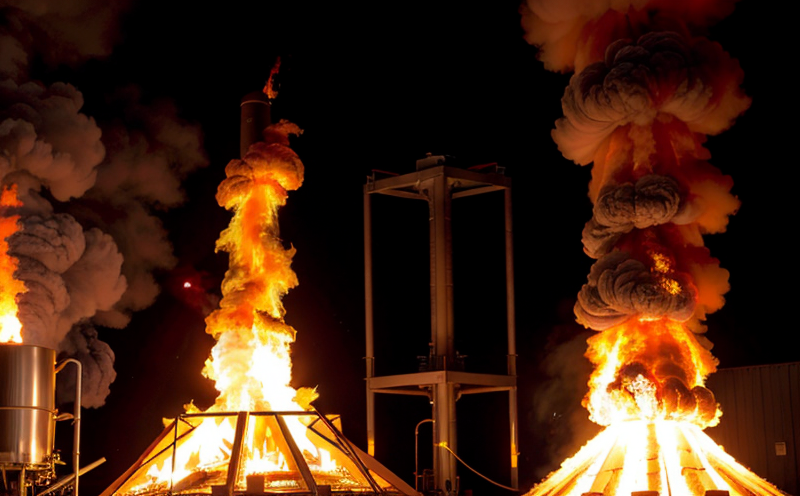Sealant Flammability Testing
In the realm of chemical testing, sealant flammability testing plays a critical role in ensuring product safety and compliance with international standards. Sealants are widely used in various sectors including construction, automotive, electronics, and aerospace due to their ability to provide structural integrity, weather resistance, and protection against environmental elements.
The primary purpose of sealant flammability testing is to assess the combustibility characteristics of these materials under controlled conditions. This helps manufacturers ensure that their products do not pose a fire hazard when used in environments where they may be exposed to ignition sources. Flammability tests are essential for compliance with regulations such as ASTM D1697, ISO 6602, and EN 13458.
The testing process involves subjecting the sealant specimens to specific heating or flame exposure scenarios designed to simulate real-world conditions of use. The results help identify potential risks associated with improper handling or installation practices. Understanding these tests is crucial for quality managers, compliance officers, R&D engineers, and procurement professionals who need to ensure their products meet safety standards.
Properly conducted flammability testing ensures that sealants are not only effective in their intended applications but also safe from a fire perspective. By adhering to industry best practices and international guidelines, laboratories can provide reliable data that supports informed decision-making throughout the product lifecycle.
| Test Parameters | Description |
|---|---|
| Heating Rate | The rate at which the specimen is heated to the ignition point. |
| Flame Duration | The duration of exposure to a flame source. |
| Specimen Size | The dimensions used for consistent testing across samples. |
| Ignition Source | The type of heat or flame applied during the test. |
These parameters are critical in determining how a sealant will behave when exposed to fire. Rigorous testing ensures that any potential issues can be identified early on, allowing for necessary adjustments before product release.
- ASTM D1697: This standard provides procedures for measuring the resistance of materials against ignition and flame spread.
- ISO 6602: Focuses on determining the relative flammability of construction products by assessing their behavior when exposed to flames.
- EN 13458: Covers the classification of fire performance requirements for building materials and elements, including sealants.
The importance of accurate testing cannot be overstated. Misleading results could lead to substandard products entering the market, posing significant safety risks. Compliance with recognized standards not only protects end-users but also enhances brand reputation through adherence to best practices.
Scope and Methodology
The scope of sealant flammability testing encompasses various aspects aimed at evaluating the combustibility properties of these materials. This includes understanding how different types of sealants react when subjected to specific environmental conditions, such as temperature changes or prolonged exposure to heat sources.
| Scope | Description |
|---|---|
| Combustibility Assessment | Evaluates the likelihood of a sealant igniting and continuing to burn beyond its initial ignition point. |
| Flame Spread Characteristics | Determines how quickly fire spreads across the surface of the specimen. |
| Smoke Production | Metric that measures the amount of smoke generated during combustion, which is important for indoor applications. |
The methodology involves precise measurement techniques and advanced instrumentation to ensure accurate data collection. Specimen preparation plays a crucial role in ensuring consistent results; this includes cutting specimens into standardized sizes and shapes suitable for testing.
Instrumentation used during these tests typically consists of specialized chambers capable of simulating realistic environmental conditions, as well as sensors designed to measure key parameters like temperature, flame height, and smoke density. These instruments provide real-time feedback that aids in making informed decisions about product modifications if required based on test outcomes.
The testing process itself follows strict protocols outlined by relevant standards such as ASTM D1697 or ISO 6602 to ensure consistency across different laboratories performing similar analyses. Compliance with these guidelines ensures reliable results which can be trusted by stakeholders involved in developing new products or approving existing ones for commercial use.
International Acceptance and Recognition
Sealant flammability testing is widely accepted across numerous countries, reflecting its importance in global safety standards. Many regions have adopted specific regulations and guidelines that specify the types of tests required for various applications.
- United States: ASTM D1697 is commonly used to evaluate sealants' resistance to ignition and flame spread.
- European Union: EN 13458 covers the fire performance requirements for building materials, including sealants.
- Canada: CSA B71.2.1 provides guidelines similar to those found in ASTM D1697 but adapted specifically for Canadian markets.
Besides regulatory compliance, acceptance of these tests extends beyond national borders into international trade agreements where mutual recognition of test methods is essential for seamless exchange between jurisdictions.
For manufacturers operating globally, ensuring their products meet local requirements helps avoid costly delays and penalties associated with non-compliance. By leveraging internationally recognized standards like those mentioned above, companies can streamline compliance processes while maintaining high-quality standards worldwide.
Use Cases and Application Examples
The application of sealant flammability testing ranges widely across industries where fire safety is paramount. Here are some examples showcasing how this service impacts different sectors:
| Sector | Application Example |
|---|---|
| Construction | Evaluating sealants used in roofs, walls, and floors to ensure they do not contribute significantly to fire spread. |
| Aerospace | Testing seals around fuel tanks or other critical components to prevent leaks that could lead to explosions. |
| Automotive | Assessing gaskets and other sealing compounds used in engines, exhaust systems, and brake assemblies for fire resistance. |
In each case, the goal is to identify any potential vulnerabilities that could compromise safety during normal operation or accidental ignition. The insights gained from these tests allow manufacturers to make informed decisions regarding material selection and design improvements necessary for meeting stringent safety criteria.





